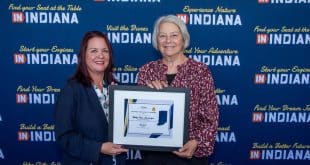INDIANAPOLIS—Butler University will welcome its third-largest class ever this fall when approximately 1,125 first-year students begin classes on August 28.
The Class of 2023 is hardly an anomaly—Butler has been experiencing a surge in interest and enrollment during the last decade. The Class of 2022, with 1,336 first-year students, is the largest class in the University’s history. The second-largest is the Class of 2020.
Since 2009, the number of applications to the University has increased by about 140 percent. This year, Butler received 14,896 first-year applications—the second-highest number ever received in an admission cycle. In 2018, the University received the most applications ever (16,431). Comparatively, in 2009, Butler received 6,243 first-year applications.
“Our growth aligns with the overall Butler 2020 strategic plan,” Vice President for Enrollment Management Lori Greene says. “We were asked to enroll 4,700 full-time undergraduate students by 2020. We are ahead of schedule. We hit 4,726 in fall 2018. Now, it is really more about sustainability and trying to determine what our ideal size is as an institution in terms of meeting the expectations of the student experience.”
So, how has Butler been able to achieve a prolonged increase in interest and enrollment when, across the nation, the benefit of a college degree is in question, college is more expensive than ever before, and private institutions face increased competition from several directions?
Greene credits Butler’s awareness of the changing landscape, as well as the University’s ability to increase its potential applicant pool.
“We have to be very mindful of all of the different choices a student has,” Greene says. “It is important that we try to engage students in deeper conversations about where they are, what they are looking to do and achieve, and how we can play a role in that on a much deeper level than ever before. Then, it comes down to expanding our markets and growing our pool to new areas.”
Expansion beyond the Midwest—where Butler has historically pulled most of its students from, Greene says—is reflected in out-of-state versus in-state application and enrollment numbers.
The recruitment team has grown its efforts in Colorado and the Mid-Atlantic, for example, building on increased student interest, and utilizing other resources such as graduate connections. There are a select number of institutions that can truly say they have a full national reach, Greene says. There are pockets where Butler can grow when it comes to awareness, and that is what the focus is on now.
There is also the fact that high school graduates in the Midwest are declining, and students have many more choices when it comes to career paths, Greene says.
“Our out-of-state number will have to grow,” Greene says.
For the Class of 2023, 55 percent come from out-of-state, and 45 percent of the class is from in-state. The majority of this year’s class is from Indiana and Illinois, but New York, Minnesota, California, and Colorado round out the top 10.
Since 2015, out-of-state applications to Butler have increased by 47 percent. There has been an increase in applications from Connecticut, Colorado, Pennsylvania, Florida, and Texas, for example.
Incoming first-year students represent 35 states and eight countries (Mexico, Sweden, Brazil, Germany, Spain, South Korea, South Africa, and China).
Despite the increases in class size, quality has not shifted, Greene says.
This year’s incoming class has 39 valedictorians, 24 Lilly Scholars, and 41 21st Century Scholars. About 20 percent graduated in the top 10 percent of their high school classes. The average GPA is 3.86.
“When you see schools go through a growth pattern, you might see quality drop,” she says. “But if anything, we are getting stronger each year. The typical Butler student is involved and is someone who is interested in raising their hand and being part of the conversation. That hasn’t changed at all.”
This year’s incoming class is also diverse, with 19 percent of the total class identifying as multicultural. This is a proportional increase from last year’s class, of which 17 percent identified as multicultural.
“That is very intentional,” Greene says. “We hope this continues to grow and we can attract students who are interested and willing in being part of a dialogue and conversation around diversity, equity, and inclusion. This doesn’t just stop with admission: This is very much about retention, as well.”
A group of activists
The Class of 2023 has also stuck out for another reason: They take an active role in the community around them and strive to shape the world they are living in.
Butler Admission Counselor Tim See visits about 100 high schools each fall. Most are on the West Coast, covering California, Oregon, Washington, Hawaii, Alaska, Nevada, and Idaho.
This class in particular, he says, had a common theme of activism and awareness of what was going on around them.
“They had a much larger view of their role in a community and were ready to hit the ground running in terms of doing something to enact change instead of searching for their voice or their role,” See said. “This was seen over and over again in essays and letters of recommendation.”
Students were leading marches, protests, and walkouts. They were starting social advocacy groups and nonprofits. Many students talked about leading or taking part in The Women’s March, as well as organizing protests in response to school shootings.
One Butler incoming first-year student, for example, volunteered at an orphanage in China, where she had been born and adopted from as a young child. One has helped bring healthy food and clean water to people in need, and another has been an advocate against racism and sexual misconduct. Right here in Indianapolis, one incoming student helped build an organization to defend his high school guidance counselor when she was fired for being married to a woman.
In so many ways, the Class of 2023 has already made an impact across the country and the world.
“Students are much more globally minded and aware,” See says. “With social media and access to knowledge and news, they understand what is going on and want to be a generation that plays a major role in making change.”
Greene says a major difference she has seen is the idea of being very involved, but not just for the sake of involvement. Students are no longer just filling up their resumes with a laundry list of activities.
“I have seen much more meaningful involvement with this generation,” Greene says. “It is typically around issues that are core and central to them as individuals.”






